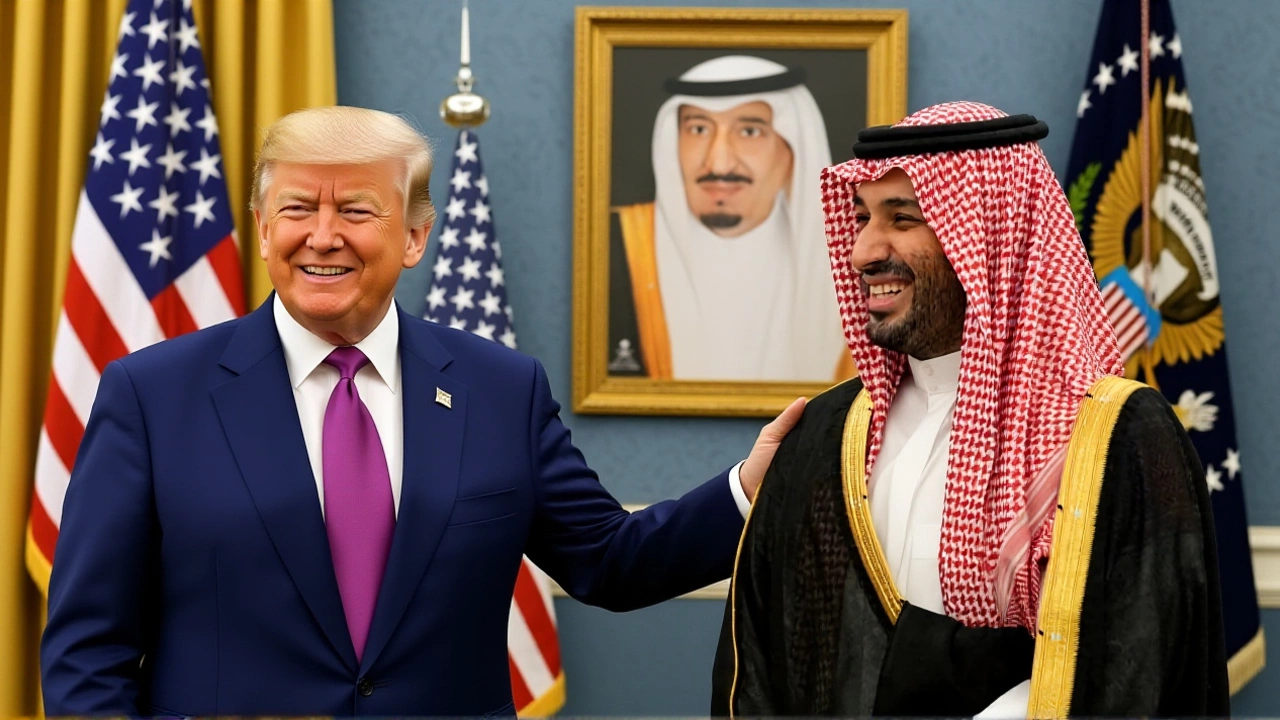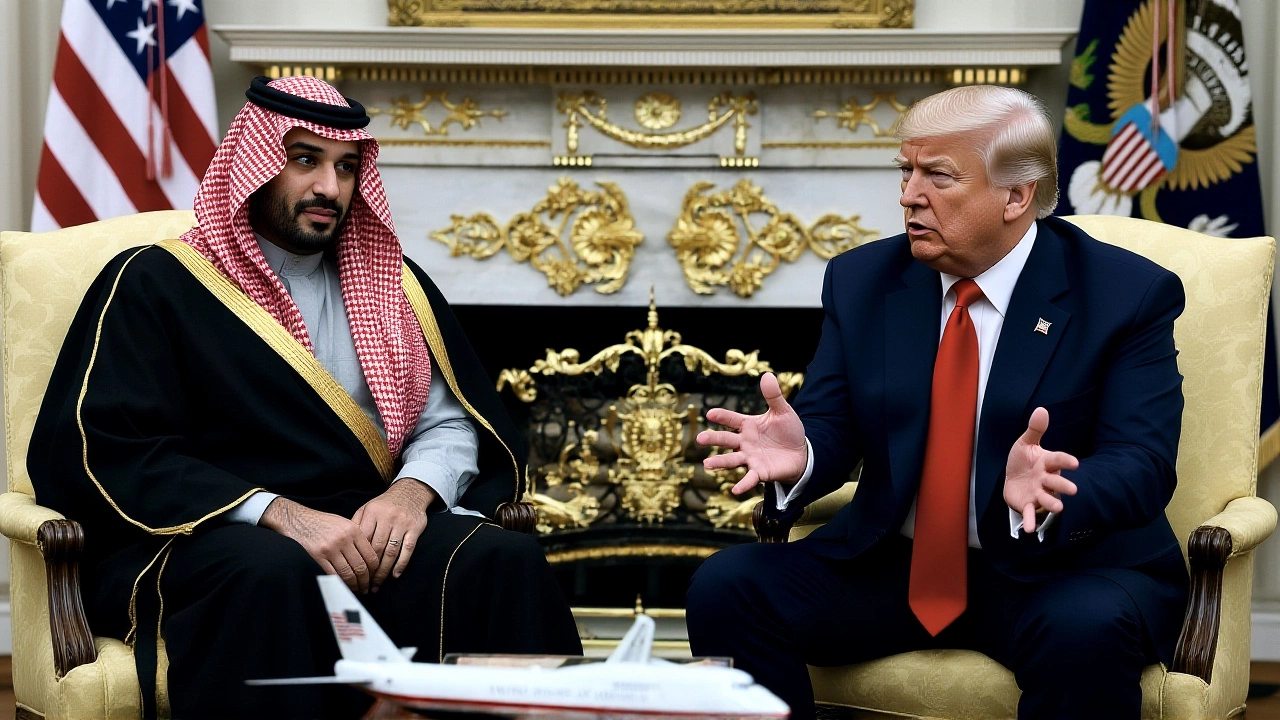On November 19, 2025, President Donald J. Trump and First Lady Melania Trump greeted Crown Prince Mohammed bin Salman at the White House in Washington, D.C., marking the start of a high-stakes visit that would reshape transatlantic economic and defense ties. The next day, November 20, 2025, the administration released a fact sheet detailing a sweeping set of agreements — including a $1 trillion Saudi investment pledge and a landmark defense pact — that officials called the most significant overhaul of U.S.-Saudi relations in decades.
A New Era of Economic Engagement
The centerpiece of the visit wasn’t just a number — it was a statement. Saudi Arabia, under Crown Prince Mohammed bin Salman, pledged nearly $1 trillion in new investments across U.S. infrastructure, energy, and technology sectors. That’s a 67% jump from the $600 billion committed during Trump’s May 2025 trip to Riyadh. The money isn’t just sitting in bank accounts; it’s earmarked for projects that will ripple through American towns — from Ohio factories to Texas refineries.
President Trump didn’t mince words. In a live moment captured on YouTube, he turned to the crowd and asked, "Where is he? Stand up. What a job you’ve done with your new engines." He was referring to executives from GE Aerospace, which stands to gain billions from new engine manufacturing deals. Trump added: "They’re building a plant for $50 billion. If you build a shopping center for $50 million, it’s okay. It’s not a bad shopping center. 50 billion... you’re talking about top of the line."
That $50 billion figure? It’s just one piece. The fact sheet lists initiatives in critical minerals, nuclear energy, and artificial intelligence — all areas where Saudi capital will partner with U.S. firms. No exact job count was given, but officials said these projects will create "high-paying American jobs" for decades. For context: a single large-scale industrial plant like GE’s new facility could employ 5,000–8,000 workers directly, plus tens of thousands in supply chains.
The U.S.-Saudi Strategic Defense Agreement: What It Really Means
While the money grabbed headlines, the real game-changer was the signing of the U.S.-Saudi Strategic Defense Agreement (SDA) on November 20, 2025. Described by the White House as "historic," the SDA formalizes what’s been an informal alliance for over 80 years — since the 1945 meeting between President Franklin D. Roosevelt and King Abdulaziz aboard the USS Quincy.
The agreement does three things, according to the fact sheet: it simplifies operations for U.S. defense contractors in Saudi Arabia, secures new "burden-sharing funds" from Riyadh to offset U.S. military costs in the region, and — crucially — locks in Saudi Arabia’s public declaration that the United States is its "primary strategic partner."
That last point matters. For years, Saudi Arabia has hedged its bets, buying arms from France, China, and Russia. Now, with the SDA, it’s choosing sides. And it’s not just rhetoric. President Trump approved a major defense sale package that includes future deliveries of the F-35 Lightning II fighter jets — the most advanced stealth aircraft in the U.S. arsenal. Lockheed Martin, the maker, will see its production lines run at full capacity for years.
"This isn’t just about weapons," said one senior defense official, speaking off-record. "It’s about trust. The Saudis are betting their national security on us. That’s huge."

Why This Matters for American Workers
The economic impact isn’t theoretical. In Ohio, GE Aerospace is already expanding its Evendale campus to produce next-generation jet engines for Saudi F-15s and future F-35s. In Texas, new refineries are being planned with Saudi funding. In Nevada, a joint venture between U.S. mining firms and Saudi sovereign wealth funds is preparing to extract lithium and rare earths for batteries and defense tech.
These aren’t temporary contracts. They’re multi-decade partnerships. The White House claims the deals will "deliver massive returns for American workers and families for decades to come." And while exact GDP projections weren’t released, analysts at the Peterson Institute estimate the $1 trillion in direct investment could add 0.8% to U.S. GDP over the next ten years — roughly $200 billion in new economic output.
Trump’s framing was blunt: "Friends, some of our friends treated us far worse than our enemies on trade anyway, and we’ve got that all straightened out and everybody’s happy. They respect us again." It’s a message aimed squarely at his base — the working-class voters who feel globalization left them behind.
What Comes Next?
Now that the ink is dry, the real work begins. U.S. defense firms must navigate Saudi Arabia’s complex procurement bureaucracy. The Saudis must prove they can handle advanced U.S. tech without leaks or misuse. And Congress will have to approve the F-35 sales — a process that could face resistance from human rights advocates.
Still, the momentum is undeniable. Saudi Arabia’s Crown Prince has made it clear: he wants to move beyond oil. And Washington, under Trump, is ready to sell him the tools to do it — from AI chips to fighter jets. The result? A new Cold War-era-style alliance, but this time, it’s economic as much as it is military.

Background: The Long Road to Trillion
The $600 billion commitment in May 2025 was already the largest single foreign investment pledge ever made to the U.S. But the November 2025 deal dwarfs it. What’s different this time? Saudi Arabia is no longer just buying American goods — it’s co-investing in American industry. The Kingdom is putting its own money into U.S.-based manufacturing, not just purchasing finished products.
Also worth noting: Crown Prince Mohammed bin Salman, born August 31, 1985, has held the dual roles of Crown Prince and Prime Minister since 2022. He’s now in his second term as the de facto ruler of Saudi Arabia, and his vision — "Vision 2030" — is all about economic diversification. The U.S. is his most reliable partner for that.
Meanwhile, President Trump, born June 14, 1946, in Queens, New York, is serving his second non-consecutive term. His administration has made the Middle East a cornerstone of its foreign policy — not through diplomacy alone, but through hard deals and hard power.
Frequently Asked Questions
How will the $1 trillion investment affect U.S. jobs?
While exact numbers aren’t released, the White House says the investments will create "high-paying American jobs" across manufacturing, energy, and tech. GE Aerospace alone plans to expand its Ohio facility with $50 billion in new production. Analysts estimate the broader economic impact could add up to 200,000 direct and indirect jobs over the next decade, especially in states like Ohio, Texas, and Nevada where industrial and mining projects are underway.
Why is the F-35 sale so significant?
The F-35 is the most advanced stealth fighter in the world, and the U.S. has long restricted its export to close allies. Selling it to Saudi Arabia — a country with a controversial human rights record — signals a major shift in U.S. defense policy. It also ensures Lockheed Martin’s production line stays full for years, supporting thousands of jobs in Georgia, Texas, and California. The deal is politically sensitive but economically vital.
What does "burden-sharing" mean in the defense agreement?
"Burden-sharing" means Saudi Arabia will pay part of the cost for U.S. military presence in the Middle East — something Washington has demanded for decades. Instead of the U.S. footing the entire bill for bases and patrols, Riyadh will contribute directly. This reduces taxpayer costs and gives the U.S. more flexibility to shift forces elsewhere, like the Pacific. The exact amount isn’t public, but it’s expected to be in the billions annually.
How does this compare to past U.S.-Saudi deals?
Previous deals, like the 1970s arms sales or the 2017 Trump visit that netted $110 billion, were mostly arms purchases. This time, Saudi Arabia is investing directly in U.S. infrastructure, factories, and tech R&D. It’s a transition from buyer-seller to strategic partner. The $1 trillion figure is unprecedented — more than the entire annual GDP of countries like Denmark or Ireland.
Is there any political opposition to these deals?
Yes. Human rights groups and some Democratic lawmakers have criticized the F-35 sale and the lack of conditions tied to Saudi Arabia’s record on dissent and Yemen. Congressional approval for the arms package is not guaranteed. However, with strong support from defense industry lobbying groups and key Republican senators, the deals are likely to pass, even if with some amendments.
What’s next for U.S.-Saudi relations after this agreement?
The next phase will involve joint tech ventures in AI, nuclear energy, and space. Saudi Arabia plans to build its first nuclear power plants with U.S. assistance, and both nations are exploring a joint satellite program. A follow-up summit is expected in early 2026 to finalize the first wave of infrastructure projects. The goal? To turn the partnership into a permanent pillar of U.S. foreign policy — beyond any single administration.





Tulis komentar